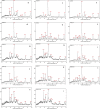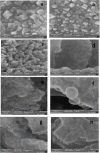Green and environmentally friendly synthesis of silver nanoparticles with antibacterial properties from some medicinal plants
- PMID: 38263231
- PMCID: PMC10807138
- DOI: 10.1186/s12896-023-00828-z
Green and environmentally friendly synthesis of silver nanoparticles with antibacterial properties from some medicinal plants
Abstract
Recently there have been a variety of methods to synthesize silver nanoparticles, among which the biosynthesis method is more noticeable due to features like being eco-friendly, simple, and cost-efficient. The present study aims for the green synthesis of silver nanoparticles from the extract of the three plants A. wilhelmsi, M. chamomilla, and C. longa; moreover, it pledges to measure the antibacterial activity against some variants causing a skin rash. The morphology and size of the synthesized silver nanoparticles were evaluated by UV.vis, XRD, SEM, and FTIR analyses. Then results showed a color alteration from light yellow to dark brown and the formation of silver nanoparticles. The absorption peak with the wavelength of approximately 450 nm resulting from the Spectrophotometry analysis confirmed the synthesis of silver nanoparticles. The presence of strong and wide peaks in FTIR indicated the presence of OH groups. The SEM results showed that most synthesized nanoparticles had a spherical angular structure and their size was about 10 to 20 nm. The highest inhibition power was demonstrated by silver nanoparticles synthesized from the extract combined from all three species against Gram-positive bacteria Staphylococcus aureus and Staphylococcus epidermidis (23 mm) which had a performance far more powerful than the extract. Thus, it can be understood that the nanoparticles synthesized from these three species can act as potential environment-friendly alternatives to inhibit some variations causing skin disorders; an issue that calls for further clinical studies.
Keywords: Anti-microbial activity; Extract; Green synthesis; Nanotechnology; Wound healing.
© 2024. The Author(s).
Conflict of interest statement
The authors declare no competing interests.
The authors declare that they have no known competing financial interests or personal relationships that could have appeared to influence the work reported in this paper.
Figures













Similar articles
-
Investigating the Possibility of Green Synthesis of Silver Nanoparticles Using Vaccinium arctostaphlyos Extract and Evaluating Its Antibacterial Properties.Biomed Res Int. 2021 Apr 30;2021:5572252. doi: 10.1155/2021/5572252. eCollection 2021. Biomed Res Int. 2021. Retraction in: Biomed Res Int. 2024 Mar 20;2024:9835064. doi: 10.1155/2024/9835064. PMID: 33997013 Free PMC article. Retracted.
-
In vitro Studies on Cytotoxic, DNA Protecting, Antibiofilm and Antibacterial Effects of Biogenic Silver Nanoparticles Prepared with Bergenia ciliata Rhizome Extract.Curr Pharm Biotechnol. 2018;19(1):68-78. doi: 10.2174/1389201019666180417160049. Curr Pharm Biotechnol. 2018. PMID: 29667550
-
Synthesis, Characteristation and Biological Activity of Silver Nanoparticles Generated Using the Leaf and Stembark Extract of Combretum erythrophyllum.Anticancer Agents Med Chem. 2023;23(13):1545-1566. doi: 10.2174/1871520623666230417112903. Anticancer Agents Med Chem. 2023. PMID: 37073157
-
Biosynthesis of Silver Nanoparticles from Melia azedarach: Enhancement of Antibacterial, Wound Healing, Antidiabetic and Antioxidant Activities.Int J Nanomedicine. 2019 Dec 11;14:9823-9836. doi: 10.2147/IJN.S231340. eCollection 2019. Int J Nanomedicine. 2019. PMID: 31849471 Free PMC article.
-
Plant-mediated synthesis of silver nanoparticles: unlocking their pharmacological potential-a comprehensive review.Front Bioeng Biotechnol. 2024 Jan 9;11:1324805. doi: 10.3389/fbioe.2023.1324805. eCollection 2023. Front Bioeng Biotechnol. 2024. PMID: 38264582 Free PMC article. Review.
Cited by
-
Fusarium oxysporum assisted green synthesis of small-sized silver nanoparticles for high antibacterial, and photocatalytic decolorization performances.BMC Microbiol. 2025 Jan 6;25(1):4. doi: 10.1186/s12866-024-03686-7. BMC Microbiol. 2025. PMID: 39762728 Free PMC article.
-
Green synthesis of nanoselenium by Ferula assa-foetida (L.) root extract: Docking study, antimicrobial activity, and its role as a biostimulant in Vicia faba (L.) seedlings.BMC Plant Biol. 2025 Jul 19;25(1):932. doi: 10.1186/s12870-025-06954-4. BMC Plant Biol. 2025. PMID: 40684143 Free PMC article.
-
Green synthesis of porphyrin-based self-assembled nanocubes for augmented sono-photodynamic inactivation of bacteria: a sustainable approach towards advanced antimicrobial strategies.Nanoscale Adv. 2024 Oct 25;6(24):6123-6128. doi: 10.1039/d4na00497c. eCollection 2024 Dec 3. Nanoscale Adv. 2024. PMID: 39569325 Free PMC article.
-
Therapeutic Efficacy of Helianthemum lippii Extract and Silver Nanoparticles Synthesized from the Extract against Cadmium-Induced Renal Nephrotoxicity in Wistar Rats.Pharmaceuticals (Basel). 2024 Jul 25;17(8):982. doi: 10.3390/ph17080982. Pharmaceuticals (Basel). 2024. PMID: 39204087 Free PMC article.
-
Silver Nanoparticles in 3D Printing: A New Frontier in Wound Healing.ACS Omega. 2024 Sep 16;9(40):41107-41129. doi: 10.1021/acsomega.4c04961. eCollection 2024 Oct 8. ACS Omega. 2024. PMID: 39398164 Free PMC article. Review.
References
-
- Bishnoi S, Kumar A, Selvaraj R. Facile synthesis of magnetic iron oxide nanoparticles using inedible Cynometra ramiflora fruit extract waste and their photocatalytic degradation of methylene blue dye. Mater Res Bull. 2018;97:121–127. doi: 10.1016/j.materresbull.2017.08.040. - DOI
-
- Sabzali Parikhani R, Sadighi H, Bijani M. Ecological Consequences of Nanotechnology in Agriculture: Researchers’ Perspective. J Agric Sci Technol. 2018;20(2):205–219.
-
- Bagherzade G, Tavakoli MM, Namaei MH. Green synthesis of silver nanoparticles using aqueous extract of saffron (Crocus sativus L.) wastages and its antibacterial activity against six bacteria. Asian Pac Tropi Biomed. 2017;7(3):227–233. doi: 10.1016/j.apjtb.2016.12.014. - DOI
-
- Khan I, Saeed K, Khan I. Nanoparticles: Properties, applications and toxicities. Arab J Chem. 2019;12(7):908–931. doi: 10.1016/j.arabjc.2017.05.011. - DOI
-
- Saha J, Begum A, Mukherjee A, Kumar S. A novel green synthesis of silver nanoparticles and their catalytic action in reduction of Methylene Blue dye. Sustain Environ Res. 2017;27(5):245–250. doi: 10.1016/j.serj.2017.04.003. - DOI
MeSH terms
Substances
LinkOut - more resources
Full Text Sources

